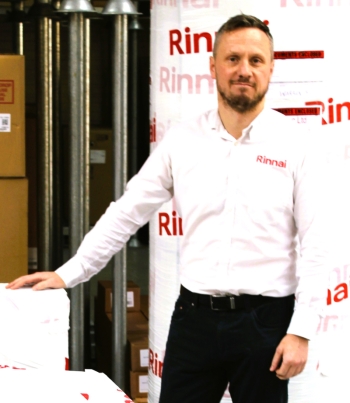Chris Goggin of Rinnai examines the work being done to enable major players in the Western and Eastern Hemispheres to position themselves at new levels of global power. Saudi Arabia, China, and the United States are pursuing different strategies that will lead to a reduction in domestic and export demand in their regions.
 Global players with financial and regional influence are working hard to keep their country in a prominent profile as they think it will rule the future in the international energy market. The three main countries are the United States, China and Saudi Arabia, all of whom have military, financial and cultural influence in the Western, Eastern and Arab world.
Global players with financial and regional influence are working hard to keep their country in a prominent profile as they think it will rule the future in the international energy market. The three main countries are the United States, China and Saudi Arabia, all of whom have military, financial and cultural influence in the Western, Eastern and Arab world.
The three are working on a project that uses three different strategies focused on implementing clean energy expansion and defining global controls for future energy markets.
The United States' energy production rate is the highest in the world. America is the world's largest producer of oil and natural gas, but forced to abandon fossil fuels under the administration of President Biden, the future US energy policy explores several ways to introduce renewable energy and hydrogen into the national energy mix. Renewable energy will focus on ocean and coastal solar, wave and wind projects.
The Japanese investment company Itochu Corporation will invest in the 160MW Prairie Switch wind project in Texas, owned by the US infrastructure investment company - Fengate Asset Management. Commercial operations will begin at the end of 2023. The offshore wind project will have 48 wind turbines each producing 3.4MW of electricity.
Five renewable energy developers have been named the winners of the California Coastal Massage Market. RWE acquired 63,338 acres of offshore land for $157.7 million. Copenhagen Infrastructure Partners purchased 69,031 acres for $173.8 million. Equinor won 80,062 acres for $130 million. Central Californian Offshore Wind was awarded 80,418 acres after accepting an offer of $150.3 million. Ultimately, Invenergy California Offshore acquired 80,418 sites for $150.3 million.
 U.S. industrial gas supplier Air Products and U.S. companies. AES Corporation will partner to invest $4 billion to build and operate a green hydrogen production facility in Wilbarger County, Utah. Texas. Commercial operations will begin in 2027.
U.S. industrial gas supplier Air Products and U.S. companies. AES Corporation will partner to invest $4 billion to build and operate a green hydrogen production facility in Wilbarger County, Utah. Texas. Commercial operations will begin in 2027.
Saudi Arabia is the main producer and supplier of oil and a source of influence in the Arab world. Saudi Arabia is one of the world's leading producers of oil and natural gas. The Saudi ruling class is a major player in global power and would like to see that continue.
If Saudi Arabia's energy and export capacity were to be removed, the current economic level would be greatly reduced. The Saudis really want to introduce a different decarbonized energy source that can be profitable. Saudi Arabia believes it has discovered this source of energy - hydrogen.
Acaw Power, the largest Saudi national energy company, will build an 8 billion dollar green hydrogen production plant near the wind products of the US, and Saudi Arabia plans a 500 billion dollar smart city, Neom. Neom itself will accept only renewable energy and will be the center of energy distribution in the future.

Acwa announced plans to re-engineer its Neom project with three other plants to produce
hydrogen. Location and pricing details have not yet been released. Acwa rea is also developing a hydrogen production plant next to OQ Energy of Oman in the Salalah Free Zone in Oman at a cost of $7 billion and is working with the South African financial institution, the Industrial Development Corporation of South Africa , to produce green hydrogen. and other green fuels, subject to agreement. which cost $10 billion. Acwa has also signed a new agreement with South Korean holding company, Posco Holdings, to develop and produce green hydrogen projects in South Korea.
China is also relying on domestic hydrogen distribution in the future for several reasons. China is completely dependent on foreign imports for its energy supply. Without imports, China cannot function as an integrated economy. Since hydrogen can be made without external help, the Chinese government is interested in a sustainable energy source that is easy to make. China's oil and gas giant Sinopec is building a hydrogen plant in the northwestern province of Xianjiang. The facility is expected to cost approximately $470 million and will be operational by June 2023.
However, there is a successful hydrogen plant in the Ningxia Autonomous Region in central China. The 200MW electrolyser is powered by solar energy and converted into green hydrogen for industrial purposes. The site is owned and operated by China's Ningxia Baofeng Energy Company.
China's iron-producing city, Tangshan - located east of Beijing in Hebei province, will be transformed into a large hydrogen production center. Plans also include converting all household cooking appliances to accept hydrogen and introducing hydrogen-powered cars on local roads. The cost of renovating the city's entire energy system with hydrogen will be approximately $746 million.
These three economies, Saudi Arabia, China and the United States, intend to introduce more energy into the country's work in the near future. Saudi Arabia will benefit from the development of the international hydrogen economy as it is the best opportunity to maintain a leading position in the international energy market. China will benefit from the ability to create a sustainable source of energy without importing while America has the two goals of decarbonizing domestic oil and remaining a world leader in energy production and export.
These three countries want to replace fossil fuels and identify renewables and hydrogen as future global energy and commercial products. Although Saudi Arabia, China and the United States hope to maintain and develop their current positions, the degree of regional influence of these countries may force similar and nearby countries to adopt measures. crops and similar distribution. market. The question of providing energy in the future will affect the geopolitical movements of each country and Saudi Arabia, China and the United States will be the three leaders.
